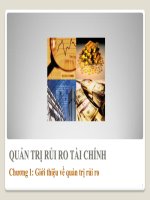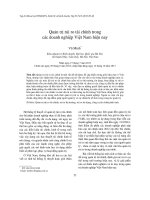quản trị rủi ro tài chính CH20 credit risk
Bạn đang xem bản rút gọn của tài liệu. Xem và tải ngay bản đầy đủ của tài liệu tại đây (806.38 KB, 45 trang )
Credit Risk
Chapter 21
Credit Ratings
In the S&P rating system, AAA is the best rating. After that comes AA, A,
BBB, BB, B, and CCC
The corresponding Moody’s ratings are Aaa, Aa, A, Baa, Ba, B, and Caa
Bonds with ratings of BBB (or Baa) and above are considered to be
“investment grade”
Historical Data
Historical data provided by rating agencies are also used to estimate the
probability of default
Cumulative Ave Default Rates (%) (1970-2003, Moody’s, Table 20.1, page 482)
1 2 3 4 5 7 10
Aaa
0.00 0.00 0.00 0.04 0.12 0.29 0.62
Aa
0.02 0.03 0.06 0.15 0.24 0.43 0.68
A
0.02 0.09 0.23 0.38 0.54 0.91 1.59
Baa
0.20 0.57 1.03 1.62 2.16 3.24 5.10
Ba
1.26 3.48 6.00 8.59 11.17 15.44 21.01
B
6.21 13.76 20.65 26.66 31.99 40.79 50.02
Caa
23.65 37.20 48.02 55.56 60.83 69.36 77.91
Interpretation
The table shows the probability of default for companies starting with
a particular credit rating
A company with an initial credit rating of Baa has a probability of
0.20% of defaulting by the end of the first year, 0.57% by the end of
the second year, and so on
Do Default Probabilities Increase with Time?
For a company that starts with a good credit rating default probabilities
tend to increase with time
For a company that starts with a poor credit rating default probabilities
tend to decrease with time
Default Intensities vs Unconditional Default Probabilities (page 482-483)
The default intensity (also called hazard rate) is the probability of default for a
certain time period conditional on no earlier default
The unconditional default probability is the probability of default for a certain time
period as seen at time zero
What are the default intensities and unconditional default probabilities for a Caa rate
company in the third year?
Recovery Rate
The recovery rate for a bond is usually defined as the price of the bond
immediately after default as a percent of its face value
Recovery Rates
(Moody’s: 1982 to 2003, Table 20.2, page 483)
Class Mean(%)
Senior Secured 51.6
Senior Unsecured 36.1
Senior Subordinated 32.5
Subordinated 31.1
Junior Subordinated 24.5
Estimating Default Probabilities
Alternatives:
Use Bond Prices
Use CDS spreads
Use Historical Data
Use Merton’s Model
Using Bond Prices (Equation 20.2, page 484)
Average default intensity over life of bond is
approximately
where s is the spread of the bond’s yield over the risk-free rate and R is the
recovery rate
R
s
−1
More Exact Calculation
Assume that a five year corporate bond pays a coupon of 6% per annum (semiannually). The
yield is 7% with continuous compounding and the yield on a similar risk-free bond is 5% (with
continuous compounding)
Price of risk-free bond is 104.09; price of corporate bond is 95.34; expected loss from defaults is
8.75
Suppose that the probability of default is Q per year and that defaults always happen half way
through a year (immediately before a coupon payment.
Calculations (Table 20.3, page 485)
Time
(yrs)
Def
Prob
Recovery Amount Risk-free Value LGD Discount Factor PV of Exp Loss
0.5
Q
40 106.73 66.73 0.9753 65.08Q
1.5
Q
40 105.97 65.97 0.9277 61.20Q
2.5
Q
40 105.17 65.17 0.8825 57.52Q
3.5
Q
40 104.34 64.34 0.8395 54.01Q
4.5
Q
40 103.46 63.46 0.7985 50.67Q
Total 288.48Q
Calculations continued
We set 288.48Q = 8.75 to get Q = 3.03%
This analysis can be extended to allow defaults to take place more
frequently
With several bonds we can use more parameters to describe the default
probability distribution
The Risk-Free Rate
The risk-free rate when default probabilities are estimated is usually
assumed to be the LIBOR/swap zero rate (or sometimes 10 bps below
the LIBOR/swap rate)
To get direct estimates of the spread of bond yields over swap rates we
can look at asset swaps
Real World vs Risk-Neutral Default Probabilities
The default probabilities backed out of bond prices or credit default swap
spreads are risk-neutral default probabilities
The default probabilities backed out of historical data are real-world
default probabilities
A Comparison
Calculate 7-year default intensities from the Moody’s data (These are
real world default probabilities)
Use Merrill Lynch data to estimate average 7-year default intensities
from bond prices (these are risk-neutral default intensities)
Assume a risk-free rate equal to the 7-year swap rate minus 10 basis
point
Real World vs Risk Neutral Default Probabilities, 7 year
averages (Table 20.4, page 487)
Rating Real-world default
probability per yr (bps)
Risk-neutral default
probability per yr (bps)
Ratio Difference
Aaa 4 67 16.8 63
Aa 6 78 13.0 72
A 13 128 9.8 115
Baa 47 238 5.1 191
Ba 240 507 2.1 267
B 749 902 1.2 153
Caa 1690 2130 1.3 440
Risk Premiums Earned By Bond Traders (Table 20.5, page 488)
Rating Bond Yield
Spread over
Treasuries
(bps)
Spread of risk-free
rate used by market
over Treasuries
(bps)
Spread to
compensate for
default rate in the
real world (bps)
Extra Risk
Premium
(bps)
Aaa 83 43 2 38
Aa 90 43 4 43
A 120 43 8 69
Baa 186 43 28 115
Ba 347 43 144 160
B 585 43 449 93
Caa 1321 43 1014 264
Possible Reasons for These Results
Corporate bonds are relatively illiquid
The subjective default probabilities of bond traders may be much higher than
the estimates from Moody’s historical data
Bonds do not default independently of each other. This leads to systematic risk
that cannot be diversified away.
Bond returns are highly skewed with limited upside. The non-systematic risk is
difficult to diversify away and may be priced by the market
Which World Should We Use?
We should use risk-neutral estimates for valuing credit derivatives and
estimating the present value of the cost of default
We should use real world estimates for calculating credit VaR and
scenario analysis
Merton’s Model (page 489-491)
Merton’s model regards the equity as an option on the assets of the firm
In a simple situation the equity value is
max(V
T
-D, 0)
where V
T
is the value of the firm and D is the debt repayment required
Equity vs. Assets
An option pricing model enables the value of the firm’s equity today, E
0
, to
be related to the value of its assets today, V
0
, and the volatility of its
assets, σ
V
E V N d De N d
d
V D r T
T
d d T
rT
V
V
V
0 0 1 2
1
0
2
2 1
2
= −
=
+ +
= −
−
( ) ( )
ln ( ) ( )
;
where
σ
σ
σ
Volatilities
This equation together with the option pricing relationship enables V
0
and σ
V
to be determined from E
0
and σ
E
σ
∂
∂
σ σ
E V V
E
E
V
V N d V
0 0 1 0
= = ( )
Example
A company’s equity is $3 million and the volatility of the equity is 80%
The risk-free rate is 5%, the debt is $10 million and time to debt maturity
is 1 year
Solving the two equations yields V
0
=12.40 and σ
v
=21.23%







